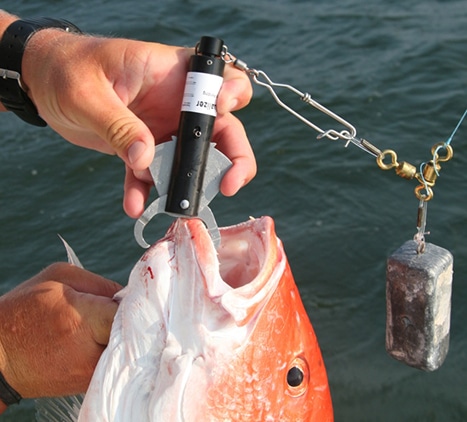
seaqualizer
A new study, being conducted at Texas A&M University-Corpus Christi, could eventually mean more days on the water for anglers looking to catch red snapper.
“This year the red snapper season was reduced to nine days, when at one time it was year-round.” said Dr. Greg Stunz, Director of the Center for Sportfish Science and Conservation at A&M-Corpus Christi. “The reduced number of days can be devastating to businesses that depend on access to the fishery for their livelihood.”
Since the season is so short, and there is a two-fish bag limit, red snapper are often required to be thrown back after they are caught.
“The current accepted practice of capturing these deep-water fish leaves fish floating behind the boat and unable to submerge to eventually die,” said Stunz. “They need to be returned to the water and preferably descended back to depth quickly to have a reasonable chance of survival.”
Stunz and his team of researchers have been experimenting with a device to do just that. It clips on to the fish so it can be lowered back into the water quickly. When the device reaches a certain depth it opens safely releases the fish. Click here to see a video of how it works.
Stunz said this type of deep-water fish is very sensitive to changes in pressure, and pulling them up quickly from deep water causes a rapid expansion of gases. Often when simply returned to the water, these fish suffer a very a high mortality rate.
The study, funded by a $205,000 grant from the National Oceanic and Atmospheric Administration, is centered on how to release the fish back without killing them, which could eventually lead to a higher population, and more fishing days.
Stunz says the primary goal is to determine if rapid recompression, using forced descent with a weight, can effectively reduce barotrauma and increase year-roundsurvival of red snapper in the Gulf of Mexico, under “real-world” fishing conditions. Any sportsman who has every brought up a fish from deep water, and seen bulging eyes and a bulging stomach, have witnesses barotrauma.
“All of the gasses have expanded in their blood stream when they are brought up,” said Stunz. “You can vent them using a hollow needle and release the air, but if you don’t know the proper technique, it can do more harm than good.”
Stunz’s team is already seeing high success in a controlled laboratory environment.
“We have done early experiments in the laboratory in hyperbaric chambers and there was some real promise in our results,” said Stunz.
Stunz and students will be testing the new device in Gulf waters over the next two years.
A U.S. Senate committee looking at the effects of over-fishing and a shortened season for red snapper, found that charter operators, marinas and recreational anglers contribute $12 billion each year to the Gulf Coast economy.
“This research may help to curb the problem of shorten seasons and bag limits for the most economically important reef fish fishery in the Gulf of Mexico,” Stunz said.
The hope is to eventually get the devices into the hands of anglers and commercial fisherman and boost the population of the red snapper.
“Red snapper is the king of fisheries in the gulf,” said Stunz. “All indications are that this will work out on the water.”
_About the HRI:___ The Harte Research Institute, an endowed research component of Texas A&M University-Corpus Christi, is dedicated to advancing the long-term sustainable use and conservation of the Gulf of Mexico. Expertise at the Harte Research Institute (HRI) includes the consequences and long-term effects of the Deepwater Horizon oil spill. The Harte Research Institute is made possible by an endowment from the Ed Harte family. For more information, go to http://www.harteresearchinstitute.org/.__
_About Texas A&M University-Corpus Christi___: Offering more than 60 of the most popular degree programs in the state, Texas A&M-Corpus Christi has proudly provided a solid academic reputation, renowned faculty, and highly-rated degree programs since 1947. The Island University has earned its spot as a premier doctoral-granting institution, supporting two research institutes and 10 research centers and labs. Discover your island at tamucc.edu.__








